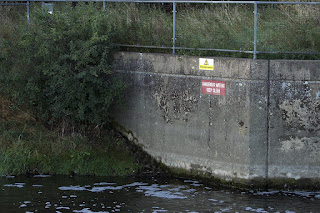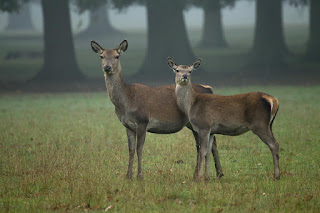Quite a few people are asking about the Otters at Kempston Mill, they have never seen them so how do I do it? The answer to this question is not straight forward because there are many things, that need to come together, to see these animals in the wild. Here are some hints and tips for Kempston Mill but they may help you on your local patch.
1. How do we know Otters are in the area?
Spraint is the word used for Otter droppings. Otters spraint to mark their territory so they like to leave them somewhere prominent, in their terms. Quite often man made structures become ideal spraint points, for example ledges under bridges, overflow pipes between lakes and rivers and the following:
 |
| Concrete outflow |
 |
| Zoomed in on the above outflow, a very popular spraint point! |
 |
| A very fresh spraint! |
 |
| Spraint on the steps by Kempston Weir |
These man made spraint points are particularly useful, during dry periods, because you can see that they have been used recently by the wet patches where the animals come out of the water. This helps because you don't have to keep track of the number of spraints and you have a reasonable idea of how recently the animals were there. With the steps at the weir they use the top step so you can see damp patches on each step when they have been there recently.
Natural spraint points are many and varied but tree roots are often used.
 |
| Large tree with prominent root system |
 |
| Zoomed into the above tree root, spraint circled |
This tree is just a few yards up stream from the concrete outflow.
Tracks are another useful thing to learn so you can check out the muddy river banks. I don't find this option as useful here because it is well used by dog walkers so there are hundreds of tracks to pick through.
The other thing that is a dead give away at the moment is the discarded Crayfish claws along the bank.
 |
| Crayfish head and claws |
The Otters certainly seem to like Crayfish:
 |
| The slope by the weir wall is a regular eating spot |
 |
| Double click for the full size image and count the claws! |
2. So we know the animals are here now it's just a matter of spotting them.
Timing is critical, these inland Otters are mostly nocturnal as they don't like meeting up with Humans and dogs, so night is likely the best time but we humans don't see too well in the dark! So it has to be dawn and dusk to give us half a chance. I'm a morning person so all of my sightings have been around dawn and a little after.
So it's dawn and you are in the right place where is that Otter? Swimming up the middle of the river giving great views, right? Wrong!
Occasionally they are but most of the time they are under the water grubbing around in the reeds and tree roots at the edge of the river looking for food so you have to look carefully. You are looking for ripples and bubbles fizzing up to the surface, maybe some reeds are moving, but there is no wind. A long stream of bubbles as an Otter moves across the river underwater. These are all pointers to there being an Otter in the area. With experience the ripples differ from those of other animals and birds on the river. Otters are large animals, up to 1.2m long, so the waves tend to be quite large, unlike those of dabbling ducks or feeding Moorhens and Coots. Swans make a similar sized wave and can catch you out if they are feeding in a reed bed.
Even when you have seen all these signs you may have to be patient. I have followed these signs for 100+ yards along the river before finally getting a glimpse of the animal itself. Last time I was out I was convinced there were 2 Otters in the area but it was 200 yards up stream before I saw one and then the other to confirm it.
Otters tend to be silent in the water unless startled when they do a loud splash as they crash dive and get out of the area. They are quite noisy eaters though and there have been times when I have heard an Otter chomping on something and that has been the sign that it is around. They often take larger prey items onto shore, usually under the cover of some thick vegetation, or the fishing platforms that can be seen along the bank here. If you do happen to hear them like this then patience is required as you wait for them to finish their meal and get back out hunting.
Otters are also masters at giving you the slip. They can move good distances underwater without a bubble or ripple to give them away. In my experience once you have a general direction of travel along the river then you can usually rely on them continuing that way. If you lose them then continue along the bank looking for the signs again, often you will relocate them, but not always.
 |
| Otter |
It is also useful to watch the behaviour of other wildlife in the area. Most birds like to keep well away from Otters and will move out of an area when an Otter arrives. A Moorhen might take to a tree, which is unusual, so this behaviour may point to there being an Otter around. Even Mute Swans are not happy when Otters are close by and will start their characteristic hissing. So keep an eye on what else is happening around you, don't just focus on the Otter itself.
3. Time of year.
I've had a great year this year as the resident female had 2 well grown cubs with her through the spring and summer. Normally I don't expect many sightings after early spring through the summer until late autumn. This year has been different, with the 2 cubs in tow, the female had to work harder and longer to get enough food for the whole family, and now it appears that the 2 cubs have not moved far out of the females territory and are still together.
It doesn't help in the summer with all the bank side vegetation blocking the view of the water which may be more of a factor in not seeing Otters at this time in other years. Of course the extra vegetation also works in your favour in that you can keep out of view of the Otter and that brings me on to the next section.
4. Frequency of visits
I visit the site most days so I have a lot of time in the field giving me a lot of opportunity to see Otters. General rule of thumb would be a sighting every 1 or 2 weeks, sometimes better, sometimes worse. So I am getting a lot of sightings but more often than not it's a bust, except that there is plenty of other stuff to see and hear.
5. Camouflage
I don't go out in a ghillie suit but I try to keep a low profile. Often I have been within feet of the animals and just by squatting or kneeling down and keeping my face covered, by the camera, they don't seem to know I am a human (I don't know what that says about me!), so they just carry on their business. Other times they see you and crash dive, never to be seen again! So keep as quiet as possible and keep out of sight where possible. Covering your face is generally a good idea when wildlife watching so in winter wear a scarf or a Buff, lots of wildlife seems to recognise the human face and associates it with a bad time, I can't think why!
6. Gotchas
Mink may catch you out as they are good swimmers, on and under the water, but they are half the size of an Otter and tend to utilise the bank more than an Otter would. Mink will run along the bank for some distance, Otters often come out on the bank but usually go back into the water to move further along the river. I've heard it said that Otters drive Mink out of an area but that certainly hasn't been my experience here. I've had a Mink moving along one side of the river while an Otter has been working the other side. There is some overlap in their prey items but enough variation that they seem to tolerate each other in the same area.
 |
| Mink |
7. Other info
My patch extends from Kempston Mill up to the island in Biddenham Loop Country Park, I seldom go further up river but I know the Otter(s) have been seen further up stream between there and Bromham Bridge, at least.
Here is a
link to a map of the Kempston Mill area with relevant points marked.
Check out this
link for some great information on Otters from the Sussex Otters and Rivers Partnership.














